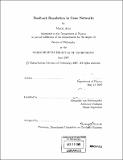Feedback regulation in gene networks
Author(s)
Acar, Murat
DownloadFull printable version (17.80Mb)
Other Contributors
Massachusetts Institute of Technology. Dept. of Physics.
Advisor
Alexander van Oudenaarden.
Terms of use
Metadata
Show full item recordAbstract
Cellular genetic information is encoded in DNA. The passage of this information from DNA to proteins is regulated at multiple levels and each level gives cells the chance to control the structure and function of their components. Transcriptional regulation is an important part of this multi-level process. By using feedback loops as part of transcriptional gene networks, cells can tune the level and stability of gene expression. In the first half of my thesis, I will discuss how isogenic cells can be re-programmed to have varying levels of memory associated with previous growth conditions and how genetic noise limits the stability of this cellular memory. Noise in gene expression, through the phenotypic heterogeneity it promotes, has the potential to be a mechanism implemented by cells to cope with the uncertainties in environmental conditions. By randomly expressing multiple phenotypes, each fit to a certain environment, cells can survive unexpected changes in the extracellular environment. In this way, a population can hedge its bets against environmental uncertainty. Depending on how often the cells choose to display various phenotypes, the population can range from being highly diverse (heterogeneous) to being less diverse (homogeneous). In the second half of my thesis, I will discuss how the degree of phenotypic diversity for an isogenic population of cells can be tuned by re-engineering a gene network. I will present results from experiments which test the effect of noise-induced diversity on population fitness in the presence of fluctuating environments. The results demonstrate that for an optimum population growth in fluctuating environments, cells need to match the rates of inter-phenotypic switching to the frequency of environmental changes.
Description
Thesis (Ph. D.)--Massachusetts Institute of Technology, Dept. of Physics, 2007. Includes bibliographical references (p. 97-104).
Date issued
2007Department
Massachusetts Institute of Technology. Department of PhysicsPublisher
Massachusetts Institute of Technology
Keywords
Physics.